Water is leaking from a gas boiler: what to do if heating system equipment leaks
If you see that water is leaking from a gas boiler, do not put off solving this problem.After all, you don’t want to replace the entire boiler because of a small crack in the heat exchanger, do you? Let’s say right away that coolant leaks occur for other reasons and in other places. How to detect and eliminate them is the topic of our article.
We will tell you what signs you can use to quickly identify a leak. We will tell you which structural components are most susceptible to loss of tightness. Our recommendations will help you quickly identify the cause in order to eliminate it without waiting for breakdowns beyond repair.
The content of the article:
Locations of water leaks
Leaks can occur along the entire water path. If a double-circuit gas boiler is leaking, the problem may be in the following components:
- heat exchanger;
- pipes;
- expansion tank;
- places of detachable connections.
The level of complexity of the upcoming repair largely depends on the location of the water leak.
The easiest way to eliminate leaks is at detachable connections. It is more difficult to repair a leaking pipeline inside the equipment. The most labor-intensive process is repairing or replacing the heat exchanger.
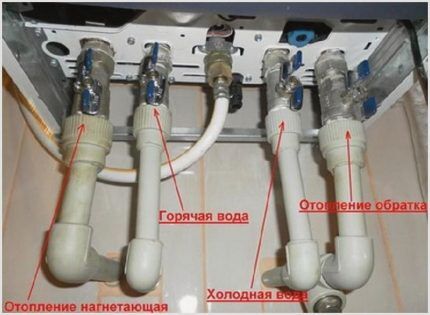
Leaks must be repaired as quickly as possible after they occur. Loss of coolant can lead to automatic shutdown of the boiler.
An attempt to compensate for the loss of coolant by periodically adding a new portion is fraught with accelerated wear of the boiler. Water is saturated with oxygen, which accelerates the corrosion of metal components, which reduces the life of heating equipment.
How can you tell if your boiler is leaking?
A coolant leak reduces the hydraulic pressure in the heating system. Let us say right away that pressure can change for other reasons, for example, due to changes in the density of water. But if the pressure gauge needle stubbornly falls down or a notification about a lack of water in the system appears on the display, you must definitely check for leaks.
Problem areas are inspected: primarily detachable connections, including taps. But the location of the leak cannot always be determined visually, because coolant it will not necessarily flow in a continuous stream, flooding the floor. Most often it just drips. When the droplets fall on hot surfaces they evaporate.
Therefore, you need to pay attention not only to wet places, but also to traces of drips and rust stains. It is better to look for leaks with a flashlight; inspect hard-to-reach areas with a mirror. Place napkins under possible leaks. Getting them wet will confirm that there is a coolant leak.
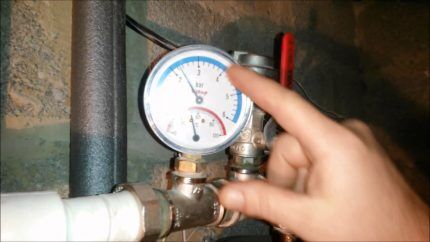
If a leak is indicated only by a drop in pressure, the problem may not be in the boiler, but in other elements of the heating system, including radiators, which also need to be checked.
It can be done as follows: water is drained from the circuit and air is pumped in using a compressor.It will come out of the leak with a characteristic noise. If the pipes are laid under tiles or in concrete floors, you will have to use a phonendoscope to hear the sound of the air escaping. Also in this case, leak detection can be done using a thermal imager.
What to do with condensate?
A puddle of water under the boiler is not necessarily a sign of a leak. Perhaps this is condensate, that is, water formed when steam condenses.
When the boiler starts, air containing moisture enters its combustion chamber. When a gas-air mixture burns, this moisture turns into hot steam much faster than the coolant heats up. The vapors come into contact with the still cold surface of the heat exchanger and settle on it in the form of condensate.
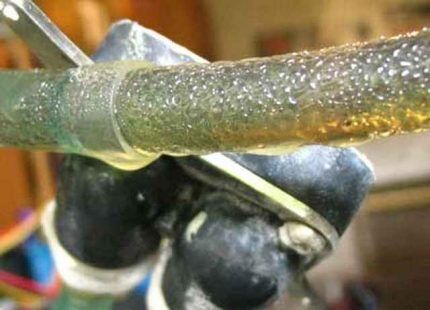
After the coolant warms up to 60-70 degrees, the condensate evaporates. To speed up this process, when starting the boiler, you can set the adjustment knob to the appropriate division, and then, if necessary, reduce the heating to 40-50 degrees.
The formation of condensation when the boiler has been operating for a long time with a coolant temperature above 60 degrees may indicate improper organization of the heating system. It is worth checking again to see if any mistakes were made during the design and installation of the harness.
The problem cannot be underestimated condensation formation, since prolonged exposure to an acidic environment on metal surfaces leads to their corrosion. Wet surfaces attract soot, which deteriorates the thermal conductivity and reduces the efficiency of the boiler.
Condensation also settles on the internal surfaces of uninsulated chimneys, which leads to accelerated contamination and wear. Insulating the chimney helps solve the problem.
Leaking through threaded connections?
The boiler heating circuit is closed. The heated coolant flows from the heat exchanger tube into the supply pipe and then into the radiators. The coolant returns through the return pipeline, entering the heat exchanger again and then continuing to circulate in a circle.
The heating circuit pipes are connected to the supply and return pipelines using threaded (detachable) connections using connecting parts - connectors with union nuts, or otherwise American ones.

Threaded connections are sealed with elastic, heat-resistant ring-shaped seals. When they wear out or are installed incorrectly, water leakage occurs. Poorly tightened nuts lead to the same consequences.
If you see water dripping at the threaded connection, you should first try tightening the nut. There is no need for excessive zeal here, since if the nut is tightened too much, it may break. If water leakage continues after tightening the nut, the seal must be replaced.
Turn off the gas and water supplies in advance and drain the water from the heat exchanger. Unscrew the union nut, replace the seals and install the nut in place.
Manufacturers of heating boilers seal detachable connections using gaskets made of rubber, silicone, paronite or other elastic materials. They are easy to use, durable and always available for sale. They often come complete with clamps.When choosing gaskets, take into account the thread size.
You can also use sanitary flax as a sealant. Regardless of the presence of leaks, seals are changed every time water communications are dismantled.
The problem is in the expansion tank
The volume of water filling the heating circuit varies depending on the heating level. As the temperature rises, the volume of water increases, which entails a change in the hydraulic pressure inside the closed heating system.
At this moment, the elements of the heating circuit would undergo increased load, fraught with their breakdown. But this does not happen, since the boiler design is complemented by a safety system, including an expansion tank, which receives the resulting excess water.
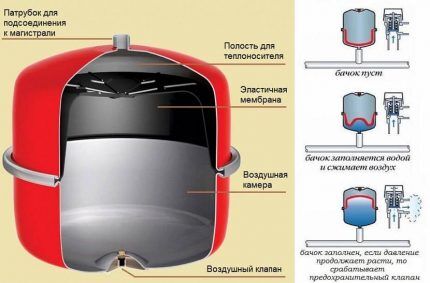
For installation on heating pipelines, open and closed expansion tanks. Open tanks are installed outside boiler rooms, for example, in attics, and are equipped with a whole system of pipes for connecting expansion, circulation, signal, and overflow pipes.
All models of wall-mounted, double- and single-circuit boilers are equipped with built-in expansion tanks. They are of the closed type, have only one pipe and two internal cavities separated by a membrane. To ensure regulatory pressure in the expansion tank, in its upper cavity there is air or an inert gas, for example, argon, and there is an air valve with a nipple.
Excess coolant flows through the pipe into the lower cavity.The membrane bends, the air is compressed in the upper cavity, and the coolant occupies part of the internal space of the expansion tank.
Excess coolant produced during heating is discharged safety valve the boiler or heating system itself. If necessary, the liquid is replenished through the boiler feed tap.
In open and closed expansion tanks, leaks occur at the threaded connections of the pipes and pipes. To eliminate them, tighten the union nuts or replace the gaskets, as discussed above.
The metal housings of expansion tanks are susceptible to corrosion due to the presence of oxygen bubbles in the water mass. Corrosion leads to the formation of fistulas (holes), which become the site of coolant leakage.
The more often you have to pump a new portion of water into the system, the higher the risk of damage to the expansion tank housing and other metal components. If there are fistulas, the tank is replaced with a new one.
Leaks through the safety valve
An important element of the safety system is the safety valve, which is necessary to “secure” the closed expansion tank. In boilers for individual heating systems, spring safety valves are usually installed.
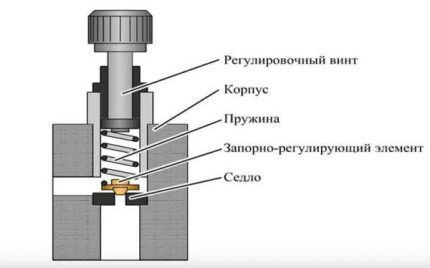
In the body of such a valve there is a metal spring that presses on the stem, and it, in turn, holds the support plate in a position where it is pressed tightly against the seat.
If, when the pressure in the heating system increases, the expansion tank for one reason or another does not cope with its functions, the coolant increases the pressure on the plate. At this moment, the spring compresses and lifts the plate above the saddle. Through the resulting hole, excess coolant flows into the drainage pipe and further into the sewer.
If the expansion tank is not selected correctly and its volume is not enough to accommodate all the incoming water, the membrane may rupture and water will fill the entire upper cavity. When the pressure increases further, it triggers safety valve, through which the resulting excess coolant is removed.
The safety valve also operates if the membrane is torn due to wear, if air leaks through a faulty nipple, or if the automatic control system malfunctions
If the connection between the valve pipe and the drain pipe is not tight enough, the coolant will end up not in the sewer, but on the floor. To prevent this from happening, during a technical inspection they pay attention to this area and, if there is the slightest leak, perform sealing.
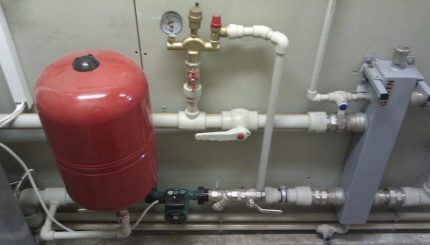
Be sure to determine the reason for the valve operation. If necessary, install a new expansion tank taking into account the volume of coolant in the system, change a worn membrane, faulty nipple or tank assembly, and solve problems with settings and control.
An emergency situation for a heating boiler is normal for the safety valve itself, because it is needed precisely in order to reduce damage from the consequences of an accident. But the valve itself may fail, causing a coolant leak.
Most often, the breakdown is associated with a spring, which is constantly under stress and eventually loses its elasticity, which leads to leaks even during normal operation of the system. The faulty valve is replaced with a new one.
When choosing a valve, its technical parameters are taken into account:
- nominal diameter of the pipe opening (DN);
- threaded connection size;
- response pressure.
The requirements for safety valves for heating systems are regulated by GOST 12.2.085-2002.
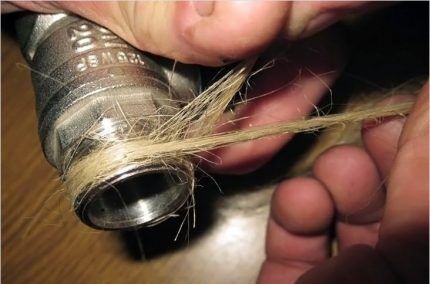
But what to do if the gas boiler leaks due to a breakdown of a recently installed valve? This happens when a grain of debris gets between the plate and the seat, for example, rust from the expansion tank. In this case, the valve is removed, washed under running water and reinstalled.
The valve is installed so that the spring is vertical. There is an arrow on the body indicating the direction of coolant flow. To seal threaded connections, heat-resistant elastic gaskets or plumbing flax are used.
Damage to the heat exchanger and pipes
If the heat exchanger of a gas boiler is leaking, the wall may have burned out, a crack or a fistula has formed. Based on the material used, heat exchangers are divided into copper, steel, and cast iron.
Cracks in metal are formed under the influence of thermal stress and hydraulic pressure. Corrosive processes lead to the formation of fistulas. Repairs are carried out by soldering.
Main stages of the process:
- dismantling the heat exchanger;
- cleaning and degreasing the area around the leak;
- soldering using flux and solder;
- trial;
- installation.
If there is a leak in an easily accessible place, complete dismantling heat exchanger for repair not required. It is enough to remove the casing, turn off the gas and water, disconnect the electrical wires, and drain the remaining water.
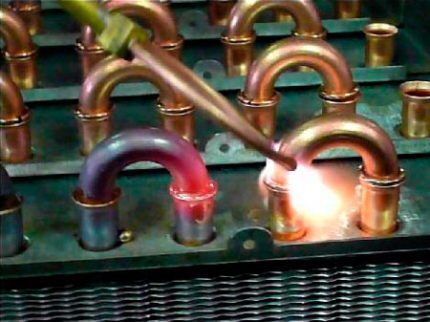
The soldering area is cleaned and degreased with a solvent. Soldering is performed using a soldering iron or gas torch. The heat exchanger is installed in place and communications are connected to it.
Tests are carried out by crimping. The circuit is filled with water, the pressure is increased to the test value and monitored using two pressure gauges for at least 5 minutes. If no pressure drop is detected and no leaks are noticed during a visual inspection, the repair can be considered complete.
In case of severe damage, repairing the heat exchanger is impractical. It is simply replaced with a new one. It is also impossible to solder many Chinese-made heat exchangers, since they are made of thin-sheet alloys that cannot withstand soldering.
Conclusions and useful video on the topic
Methods for sealing threaded connections in individual heating systems using various materials:
Eliminating a leak from an overpressure valve in a double-circuit gas boiler:
In heating boilers, coolant leakage can occur in different areas of the heating and hot water circuits. Replacing the seal on threaded connections is not difficult to do yourself. To eliminate a leak through a heat exchanger fistula, you will need the skills of a plumber and welder, considerable experience, and tools.
Repairing damaged elements is not always possible; sometimes it is more advisable to replace them. If leaks are promptly eliminated, there are no negative consequences and the boiler operates as before.
Please leave comments, ask questions, post photographs related to the topic of the article in the block below. Tell us if you have had to repair a heating unit, share the technological nuances you know. It is possible that your advice will be very useful to the readers of the site.




Hello! Please tell me what could be the problem. We encountered the following problem: the faucet in the bathroom on the first floor breaks (the thread breaks). This is repeated for the second time. Everyone else stands still.
Thanks for the article, useful and informative